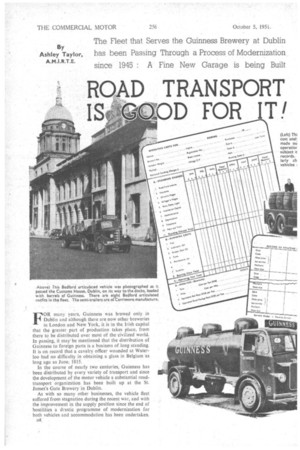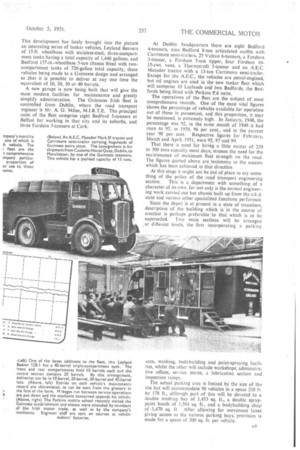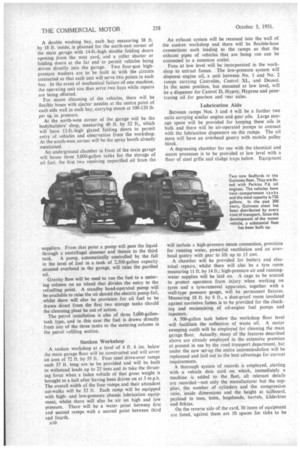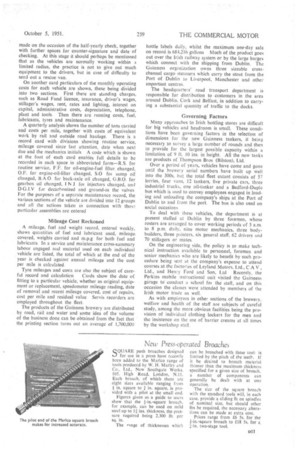ROAD TRANSPORT I OD FOR IT!
Page 48

Page 49

Page 50

Page 51

If you've noticed an error in this article please click here to report it so we can fix it.
The Fleet that Serves the Guinness Brewery at Dublin has been Passing Through a Process of Modernization since 1945 : A Fine New Garage is being Built
By Ashley Taylor,
FOR many years, Guinness was brewed only. in Dublin and although there are now other breweries in London and New York, it is in the Irish capital that the greater part of production takes place, from there to be distributed over most of the civilized world.
In passing, it may`be mentioned that the distribution of Guinness to foreign parts is a business of long standing.
It is on record that a cavalry officer wounded at Waterloo had no difficulty in obtaining a glass in Belgium as long ago as June. 1815.
In the course of nearly two centuries, Guinness has been distributed by every variety of transport and since the development of the motor vehicle a substantial road transport organization has been built up at the St.
James's Gate Brewery in Dublin.
As with so many other businesses, the vehicle fleet suffered from stagnation during the recent war, and with the improvement in the supply position since the end of hostilities a drastic programme of modernization for both vehicles and accommodation has been undertaken. D8 This development has lately brought into the pictme an interesting series of tanker vehicles, Leyland Beavers of 15-ft. wheelbase with stainless-steel, three-compartment tanks having a total capacity of 1,441) gallons, and Bedford 157-in.-wheelbase 5-ton chassis fitted with twocompartment tanks of 720-gallon total capacity, these vehicles being made to a Guinness design and arranged so .that it is possible to deliver at any one time the equivalent of 10, 20, 30 or 40 barrels.
A new garage is now being built that will give the most modern facilities for maintenance and greatly simplify administration. The Guinness Irish fleet is controlled from Dublin, where the road transport mgineer is Mr. A. G. Milne, M.1.R.T.E. The principal units of the fleet comprise eight Bedford 5-tonners at Belfast for working in that city and its suburbs, and three Fordson 5-tonners at Cork. At Dublin headquarters there are eight Bedford 4-tonners, nine Bedford 8-ton articulated outfits with Carrimore semi-trailers, 25 Vulcan 6-tonners, a Fordson 3-tonner, a Fordson 5-ton tipper, four Edrdson 1015-cwt. vans, a Thornycroft 5-tonner and an A.E.C. Matador tractor with a 13-ton Carrimore semi-trailer. Except for the A.E.C., the vehicles are petrol-engined, but oil engines are used in the new tanker fleet which will comprise 10 Leylands and two Bedfords, the Bedfords being fitted with Perkins P.6 units, The operations of the fleet are the subject of most comprehensive records. One of the most vital figures shows the percentage of vehicles available for operation out of those in possession, and this proportion, it may be mentioned, is extremely high. In January, 1948, the percentage was 92, in the same month of 1949 it had risen tei",95, in 1950, 96 per cent., and in the current year 98 per cent. Respective figures for February, March and April. 1951, were 95, 97 and 99.
That there is need for hiring a little matter of 250 to 300 tons capacity most days, stresses the need for the maintenance of maximum fleet strength on the road. The figures quoted above are testimony to the success which has been achieved in that direction At this stage it might not be out of place to say something of the policy of the road transport engineering
section. This is a department with something of a character of its oWn, for not only is the normal engineering work carried out but chassis built up from the c.k.d. state and various other specialized functions performed.
Since the depot is at present in a state of transition, description of the building which is in the course of erection is perhaps preferable ' to that which is to be superseded. Two main sections will be arranged at different levels, the first incorporating a parking area, washing, bodybuilding and paint-spraying facilities, whilst the other will include workshoi* administrative offices, service stores, a lubrication section and inspection ramps.
The actual parking area is limited by the size of the site but will accommodate 90 vehicles in a space 218 ft by 178 ft., although part of this will be devoted to a double washing bay of 1,453 sq. ft, a double spraypaint booth of 1,584 sq. ft., and a bodybuilding shop of .1,470 sq. ft. After allowing for movement lanes giving access to the various parking bays, provision is made for a space of 300 sq. ft. per vehicle. A double washing bay, each bay measuring 38 ft. by 18 ft. inside, is planned for the north-east corner of the main garage. with 14-ft.-high double folding doors opening from the west yard, and a roller shutter or folding doors at the far end to permit vehicles being driven directly into the garage. Two four-gun highpressure washers are to be built in with the circuits connected so that each unit will serve two points in each bay. In the event of mechanical failure of one machine, the operating unit can thus serve two bays while repairs are being effected.
For steam cleansing of the vehicles, there will be flexible hoses with ejector nozzles at the centre point of each side wall in each bay, carrying steam at 100-120 lb. per sq. in. pressure. At the north-west corner of the garage will be the bodybuilders' shop, measuring 40 ft. by 32 ft., which will have 12-ft-high glazed folding doors to permit entry of vehicles and observation from the workshop. At the south-west corner will he the spray booth already mentioned.
An underground chamber in front of the main garage will house three 5,000-gallon tanks for the storage of oil fuel, the first two receiving unpurified oil from the
suppliers. From that point a pump will pass the liquid through a centrifugal cleanser and thence to the third
tank. A pump, automatically controlled by the fall in the level of fuel in a tank of 2,500-gallon capacity situated overhead in the garage, will raise the purified oil.
Gravity flow will be used to run the fuel to a metering column on an island that divides the entry to the refuelling point. A standby hand-operated pump will be available to raise the oil should the electric pump fail, whilst there will also be provision for oil fuel to be drawn direct from the first two storage tanks should the cleansing plant be out of action.
The petrol installation is also of three 5,000-gallontank type, and in this case the fuel is drawn directly from any of the three tanks to the metering column in the petrol refilling section.
Sunken Workshop A sunken workshop at a level of 4 ft. 6 ins, below the main garage floor will be constructed and will cover an area of 72 ft. by 55 ft. Four steel drive-over ramps each 37 ft. long are to be provided and will be built to withstand loads up to 25 tons and to take the thrusting force when a laden vehicle of that gross weight is brought to a halt after having been driven on at 3 m.p.h. The overall width of the four ramps and their attendant cat-walks will be 52 ft. Each ramp will be equipped with highand low-pressure chassis lubrication equipment, whilst there will also be air on high and low pressure. There will be a water point between first and second ramps with a second point between third and fourth.
D10 An exhaust system will be recessed into the wall of the sunken workshop and there will be flexible-hose connections each leading to the ramps so that the exhaust pipes of vehicles that are being run can be connected to a common outlet.
Fans at low level will be incorporated in the workshop to extract fumes. The low-pressure system will dispense engine oil, a unit between No. 1 and No. 2 ramps carrying Castrolite, Castrol XL, and Deusol. In the same position, but mounted at low level, will be a dispenser for Castrol D, Hypoy, Hypress and penetrating oil for gearbox and rear axles.
Lubrication Aids Between ramps Nos. 3 and 4 will be a further two units carrying similar engine and gear oils. Large storage space will be provided for keeping these oils in bulk and there will be air-operated pumps to connect with the lubrication dispensers on the ramps. The oil store will have an overhead gantry with mobile pulley block.
A degreasing chamber for use with the 'chemical and steam processes is to be provided at low level with a floor of steel grille and sludge traps below. Equipment will include a high-pressure steam connection, provision for running water, powerful ventilation and an overhead gantry with gear to lift up to 15 cwt.
A chamber will be provided for battery and electrical repairs, whilst there will also be a tyre room measuring 11 ft. by 14 ft.; high-pressure air and runningwater supplies will be laid on. A cage to be erected to protect operators from injury when working on tyres and a tyre-removal apparatus, together with a wall-type pressure gauge, will be permanent fixtures. Measuring 18 ft. by 8 ft., a dust-proof room insulated against corrosive fumes is to be provided for the checking and maintaining of oil-engine fuel pumps and injectors.
A 500-gallon tank below the workshop floor level will facilitate the collection of waste oil. A motor sweeping outfit will be employed for cleaning the main garage floor. Actually, many of the features described above are already employed in the extensive premises at present in use by the road transport department, but under the new set-up the entire accommodation will be replanned and laid out to the best advantage for current requirements.
A thorough system of records is employed, starting with a vehicle data card on which, immediately a machine is added to the fleet, all relevant details are recorded—not only the manufacturer but the supplier, the number of cylinders and the compression ratio, inside dimensions and the height at tailboard, payload in tons, butts, hogsheads, barrels, kilderkins and firkins.
On the reverse side of the card, 30 items of equipment are listed, against them are 10 spaces for ticks to be made on the occasion of the half-yearly check, together with further spaces for counter-signature and date of checking. At this stage it should perhaps be mentioned that as the vehicles are normally working within a limited radius, the practice is not to give out much equipment to the drivers, but in case of difficulty to send out a rescue van.
On another card particulars of the monthly operating costs for each vehicle are shown, these being divided into two sections. First there are standing charges, such as Road Fund licence, insurance, driver's wages, stillager's wages, rent, rates and lighting, interest on capital, administrative costs, depreciation, telephone, plant and tools. Then there are running costs, fuel, lubricants, tyres and maintenance.
A quarterly analysis shows the number of tons carried and costs per mile, together with costs of equivalent work by rail and outside road haulage. There is a record card with divisions showing routine service, mileage covered since last attention, date when next due and the mechanics initials A code which is shown at the foot of each card enables full details to be recorded in each space in abbreviated form—R.S. for routine service, F.F. for oil-engine-fuel alter. changed, O.F. for engine-oil-filter changed, S.0 for sump oil changed, B.A.O. for back-axle oil changed, 0.13.0. for gearbox oil changed, IN J for injectors changed, and D G.I.V for decarhonizecl and ground-in the valves For the purposes of a separate maintenance record, the various sections of the vehicle are divided into. 12 grotipS and all the actions taken in connection with those particular assemblies are entered
Mileage Cost Reckoned A mileage, fuel and weight record, entered weekly, shows quantities of fuel and lubricant used, mileage covered, weights carried and m.p.g for both fuel and lubricants. In a service and maintenance cross-summary labour engaged and material used on each individual vehicle are listed, the total of which at the end of the year is checked against annual mileage and the cost per mile is calculated.
Tyre mileages and costs are also the subject of care ful record and calculation Cards show the date of fitting to a particular vehicle, whether as original equipment or replacement, speedometer mileage reading, date of removal and recent mileage covered, cost of repairs, cost per mile and residual value Servis recorders are employed throughout the fleet.
The products of the Guinness brewery are distributed by road, rail and water and some idea of the volume of the business done can be obtained from the fact that the printing section turns out an average of 1,700,000 bottle labels daily, whilst the maximum one-day sale on record is 684,216 gallons Much of the product goes out over the Irish railway system or by the large barges which connect with the shipping from Dublin. The Guinness organization owns three sizeable cross. channel cargo steamers which carry the stout from the Port of Dublin to Liverpool, Manchester and other important centres.
The headquarters' road transport department is responsible for distribution to customers in the area around Dublin. Cork and Belfast, in addition to carrying a substantial quantity of traffic to the docks.
Governing Factors
Many approaches to Irish bottling stores are difficult for big vehicles and headroom is small. These conditions have been governing factors in the selection of dimensions for the new Guinnesstankers, it being necessary to survey a large number of rounds and then to provide for the largest possible capacity within a limitation of 9 ft. 10 ins, in height. All the new tanks are products of Thompson Bros (Bilston), Ltd.
Over a period of years, vehicles have come and gone until the brewery serial numbers have built up well into the 300s, but the total fleet extant consists of 57 lorries, four vans, 12 tankers, five private cars, three industrial trucks, one oil-tanker and a Bedford-Duple bus which is used to convey employees engaged in loading and unloading the company's ships at the Port of Dublin to and from the port. The bus is also used on social occasions
To deal with these vehicles, the department is at present staffed at Dublin by three foremen, whose rosters are arranged to cover working periods of 5 a.m. to 8 p.m. daily, nine motor mechanics, three bodybuilders, three painters, six general staff, 62 drivers and 70 stillagers or mates.
On the engineering side, the policy is to make technical instruction available to personnel, foremen and senior mechanics who are likely to benefit by such procedure being sent at the company's expense to attend courses at the factories of Leyland Motors, Ltd., C.A V , Ltd., and Henry Ford and Son, Ltd Recently, the Perkins mobile instructional unit visited the Guinness 6rage to' conduct a school for the staff, and on this occasion the classes were attended by members of the Irish motor trade as well.
As with employees in other sections of the brewery, welfare and health of the staff are subjects of careful study, among the more obvious facilities being the provision of individual clothing lockers for the men and the insistence on the use of barrier creams at all times by the workshop staff.
































































































